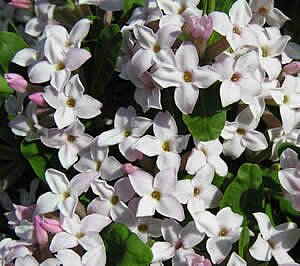[ Return ]
All You Need To Know About Daphnes
by Penny at Plant Barn Motueka,
July 22nd 2010
|

Daphne odora

Daphne burkwoodii
|
Winter is a season of little growth and colour in the garden. There are however a few winter flowering plants that are truly spectacular, one of which is Daphne odora, the winter daphne.
"Daphne" is a Greek word meaning "laurel", "odora" meaning fragrant. Daphne is grown for its marvellous fragrant flowers which appear in winter. The pale pink, tubular flowers each have four spreading lobes, and a beautiful scent. Foliage is a glossy green, but can discolour and fall due to cold weather. As this is usually immediately before full bloom, the plant retains its dignity as the emerging flowers are highlighted by the absence of leaves.
Daphne hate root disturbance and therefore dislike transplanting. Occasionally Daphne produce red berries after flowering; this should not be expected though, as it is not the norm.
Daphne grows best in cool, moist humus rich soil in full sun or part shade, thriving in an acid soil. Leaf fall or yellowing can also be a sign of chlorosis which is a result of either poor drainage or iron deficiency but is easily rectified with a side dressing of iron chelate or aluminium sulphate. Plants benefit from liquid feeding or a light side dressing of acid fertiliser. Most are fully frost hardy.
They are propagated most commonly by cutting, but they are a tricky plant to reproduce. Viral infections have historically been a problem, and whilst most plants available now are parented from virus-free tissue cultured heritage, the extensive work in developing virus-free stock ensures propagation is an expensive process.
Native to China, Japan, North Africa and Europe, there are between 40 and 50 listed varieties. However the most common in New Zealand is Daphne odora "Leucanthe" with its pink flowers. There is also a white form available but is slightly harder to get.
Also available is Daphne bholua; this variety comes from the Himalayas, has longer leaves, pale purple to rose pink flowers in mid to late winter and black berries. It can reach up to 2.5m by 2m.
Once available but rarely seen now were also Daphne burkwoodii and Daphne cnerorum, both of which have pink terminal clusters of flowers in the spring and summer. Burkwoodii grows to 1.2m and is semi-deciduous while Cnerorum is only 30cm high, evergreen and considered great for rockeries.
Visit your local garden centre to see what varieties are available.
>> , to be added to the page.
[ Return ]